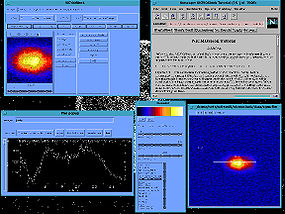
NICMOSlook
Encyclopedia

Near Infrared Camera and Multi-Object Spectrometer
The Near Infrared Camera and Multi-Object Spectrometer is a scientific instrument for infrared astronomy, installed on the Hubble Space Telescope , operating from 1997 to 1999, and from 2002 to 2008...
(NICMOS) on board the Hubble Space Telescope
Hubble Space Telescope
The Hubble Space Telescope is a space telescope that was carried into orbit by a Space Shuttle in 1990 and remains in operation. A 2.4 meter aperture telescope in low Earth orbit, Hubble's four main instruments observe in the near ultraviolet, visible, and near infrared...
(HST). The program was designed at the Space Telescope European Coordinating Facility
Space Telescope European Coordinating Facility
right|The Space Telescope - European Coordinating Facility is an institution which provides a number of support and service functions primarily for European observers of the NASA/ESA Hubble Space Telescope...
(ST-ECF) and is programmed in IDL. The program is available from their website.
One of the capabilities of NICMOS is its grism
Grism
A grism is a combination of a prism and grating arranged so that light at a chosen central wavelength passes straight through. The advantage of this arrangement is that one and the same camera can be used both for imaging and spectroscopy without having to be moved...
mode for slitless spectrometry at low resolution. Typically, a direct image is taken in conjunction with grism images for wavelength calibration. NICMOSlook is a highly specialized interactive tool to extract
one dimensional spectra (flux versus wavelength) from such data.
NICMOSlook has a non-interactive counterpart “Calnic C
Calnic C
Calnic C is a program to analyze spectral data obtained with the Near Infrared Camera and Multi-Object Spectrometer on board the Hubble Space Telescope . The program was designed at the Space Telescope European Coordinating Facility and is programmed in IDL. Maintenance of Calnic C has stopped in...
”, a program that performs a subset of NICMOSlook's functions in a "pipelined" approach. NICMOSlook is most commonly used for small amounts of data when users prefer to have full control of all the parameters for individual spectrum extraction, or for cases where Calnic C did not extract the spectra satisfactorily. Unlike Calnic C, NICMOSlook requires the user to determine the best way to find an object and provides a number of different ways to accomplish this. Similarly, the user decides whether to use a weighting appropriate for point sources or weighting by the size of the object for the extraction of the spectra.

